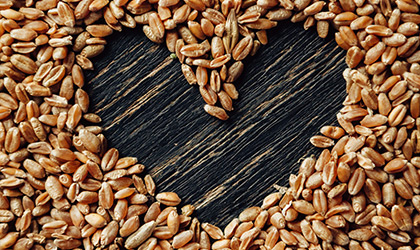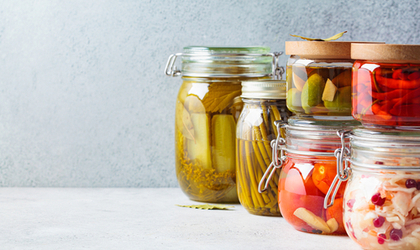
If you’ve experienced uncomfortable digestive issues shortly after eating, there’s a chance you might have a lactose intolerance – and you wouldn’t be alone. Experts estimate that around 68 per cent of the global population struggles with lactose malabsorption (1). Here, we take a look at what’s behind it.
What is lactose?
Lactose is a type of sugar mainly found in milk and dairy products, such as cheese, yogurt, and cow’s milk. Lactose is comprised of two simple sugars: glucose and galactose.
What is lactose intolerance?
 A lactose intolerance occurs when your body struggles to digest lactose. If you’re lactose intolerant, you may experience discomfort when you eat culprit lactose foods found mainly in milk and dairy products like cheese, yogurt or milk.
A lactose intolerance occurs when your body struggles to digest lactose. If you’re lactose intolerant, you may experience discomfort when you eat culprit lactose foods found mainly in milk and dairy products like cheese, yogurt or milk.
What causes lactose intolerance?
Lactose intolerance occurs because the body doesn’t have enough lactase to digest lactose. Lactase is an important enzyme produced in the small intestine that helps break down lactose in the body. Without enough lactase, lactose moves through your digestive system undigested, interacting with the bacteria in your large intestine and causing unpleasant and uncomfortable symptoms.
Types of lactose intolerance
There are four types of lactose intolerance.
Primary lactose intolerance
Primary lactose intolerance is the most commonly experienced lactose intolerance. It’s caused by a decrease in lactase production that can happen gradually with age, meaning people may lose the ability to absorb lactose as they get older.
This form of lactose intolerance often has a genetic basis and is more common among people of an Asian, African, Mediterranean, Hispanic, and southern European background.
Secondary lactose intolerance
Secondary lactose intolerance happens due to illness, or surgery - especially on the small intestine, which produces lactase. That said, if the underlying condition is managed, lactase levels may restore to their former concentrations.
Congenital lactose intolerance
In rare cases, people can inherit lactose intolerance, where a defective gene is transmitted from parent to child, leading to the complete absence of lactase. A congenital lactose intolerance means a baby will be intolerant to breast milk and need lactose-free baby formula instead.
Developmental lactose intolerance
In some instances, developmental lactose intolerance occurs when a baby is born prematurely. This happens because lactase production in infants begins later in the pregnancy, around 34 weeks.
What are the symptoms of lactose intolerance?
The symptoms of lactose intolerance generally arise between 30 minutes and two hours after consuming a lactose-containing food or drink. You may experience the following symptoms, which can range from mild to severe.
-
Bloating
-
Gas
-
Abdominal discomfort
-
Nausea
-
A change in toilet habits
Lactose intolerance vs digestive conditions
Although lactose intolerance and certain digestive complaints can both cause similar symptoms, they’re two separate conditions, differing in why they happen and how you handle them.
Lactose intolerance occurs because the body doesn’t have enough lactase to digest lactose – and it’s only triggered when you consume dairy.
Certain digestive conditions, on the other hand, has many possible causes, including long-term stress and emotional trauma, certain foods, genetic makeup, and infections in your intestines. Dairy may be a trigger for someone with certain digestive conditions, but it doesn’t always indicate the person is lactose intolerant.
Your GP can help distinguish if your symptoms stem from certain digestive conditions or lactose intolerance. To find out more about digestive conditions visit our Knowledge Hub by clicking here.
Lactose intolerance vs milk allergy
It’s also worth noting that lactose intolerance isn’t the same as a milk allergy, which occurs when your body is allergic to a protein in milk. Though there’s some crossover in symptoms with lactose intolerance, including a change in toilet habits and discomfort, a milk allergy is often characterised by hives, wheezing, swelling of the lips, tongue, and throat, and vomiting.
What foods contain lactose?
Lactose is mainly found in milk and dairy products, such as yoghurt, cheese, cow’s milk, goat’s milk, and ice cream. It can also hide in cereal, bread, salad dressings, and baked goods. Keep an eye out for the following ingredients on food labels.
-
Milk, cheese, or yoghurt
-
Milk solids or milk powder
-
Whey
-
Lactose
-
Curds
-
Cream
-
Buttermilk
-
Malted milk
Can I still eat dairy if I’m lactose intolerant?
If you have lactose intolerance, chances are, you can still digest a small amount of lactose that is present in dairy products. Some cheeses, like cheddar, Swiss, mozzarella, and yoghurt contain lower concentrations than milk, so you may find these foods easier to tolerate.
Eating other foods when you consume lactose may also help. We suggest starting with a small amount and checking how you feel. Keeping a food diary to record symptoms can be extremely useful.
What happens if you ignore lactose intolerance?
Lactose intolerance can lead to serious digestive issues for those who continue to eat lactose-containing foods. Left unmanaged, it may cause discomfort, which can affect your emotional, mental, and physical well-being over time.
Moreover, since milk and milk products are some of the richest dietary sources of calcium and vitamin D3, lactose intolerance can also prevent you from getting enough of these nutrients. Calcium and vitamin D3 are exceptionally important for bone health. So, if you overlook lactose intolerance, your bone health may be at risk.
Can lactose intolerance go away?
Unfortunately, there’s no cure for lactose intolerance; you can’t make your body produce more lactase. The only way to manage your symptoms is by limiting your intake of food and drink containing lactose.
Tips on going lactose-free
If you want to get on top of your lactose intolerance, the best lactose intolerant treatment is to avoid lactose-containing foods. This can feel overwhelming initially, but there’s no need to worry. Here are our top tips for making the transition easier.
Get to know dairy-free alternatives
Enjoying milk, cheese, butter, yoghurt, and ice cream isn’t entirely out of the question if you’re lactose-free. Plant-based products are all the rage these days – and they give their dairy counterparts a run for their money in terms of taste, texture and flavour. Simply use them as an alternative to dairy products in your favourite recipes.
Have lactose-free snacks
Hunger is often a by-product of dietary changes, so it’s important to keep your kitchen stocked with plenty of lactose-free snacks. Think coconut yoghurt, dark chocolate (70%), nuts, dairy-free ice cream, and plenty of nut milk for hot drinks and smoothies.
Focus on what you can have rather than what you can’t
It’s easy to feel disheartened about the dietary changes you need to make when you first go lactose-free. But the truth is you can still enjoy many delicious foods. Try to see this shift as an opportunity to be more creative, curious, and adventurous with cooking rather than limiting.
If you’re looking for inspiration, you can find some of our favourite lactose-free recipes here.
Get enough calcium and vitamin D3
Ensuring you get enough calcium and vitamin D3 is another important consideration if you’re lactose intolerant. Fortunately, plenty of calcium-rich foods are, in fact, dairy-free. They include:
-
Green leafy vegetables, like broccoli, collard, kale, and bok choy
-
Beans, such as kidney beans, chickpeas, cannellini, and pinto beans
-
Nuts and seeds, like sesame seeds and almonds
-
Canned fish, such as sardines, anchovies, and salmon
-
Soybean-based foods, including tofu and edamame
-
Calcium-fortified dairy-free milk, like almond, soy, and rice
You can find vitamin D3 in egg yolks, oily fish (salmon, sardines, and mackerel), and fortified plant-based milk.
For nutritional support, you may wish to take a comprehensive multivitamin that delivers good levels of both calcium and vitamin D3 to support your nutritional reserves. Look for at least 10µg of vitamin D3 and between 100mg and 300mg of calcium.
Lactase tablets
Lactase is a digestive enzyme required to break down lactose, a type of sugar found in milk and dairy products. Lactase tablets, therefore, can be useful on occasions when you might be consuming dairy. Lactase 9000 provides massive 9000 FCC units of enzyme activity to support the digestion of lactose.
There are many different types of lactase tablets on the market: chewable, capsules, and traditional tablets. While they all have their merit, we will always advocate lactase tablets over chewable and capsule varieties as they release lactase where it’s needed and have fewer excipients.
Want to learn more?
If you’re looking for more help managing lactose intolerance, please get in touch with our team of expert Nutrition Advisors, who are on hand to provide free, confidential advice. Or head to our knowledge hub to learn more about digestive health.
References:
-
Definition & Facts for lactose intolerance (2023) National Institute of Diabetes and Digestive and Kidney Diseases. U.S. Department of Health and Human Services. Available online: https://www.niddk.nih.gov/health-information/digestive-diseases/lactose-intolerance/definition-facts
You Might Also Like

Olivia
Olivia Salter has always been an avid health nut. After graduating from the University of Bristol, she began working for a nutritional consultancy where she discovered her passion for all things wellness-related. There, she executed much of the company’s content marketing strategy and found her niche in health writing, publishing articles in Women’s Health, Mind Body Green, Thrive and Psychologies.
View More



